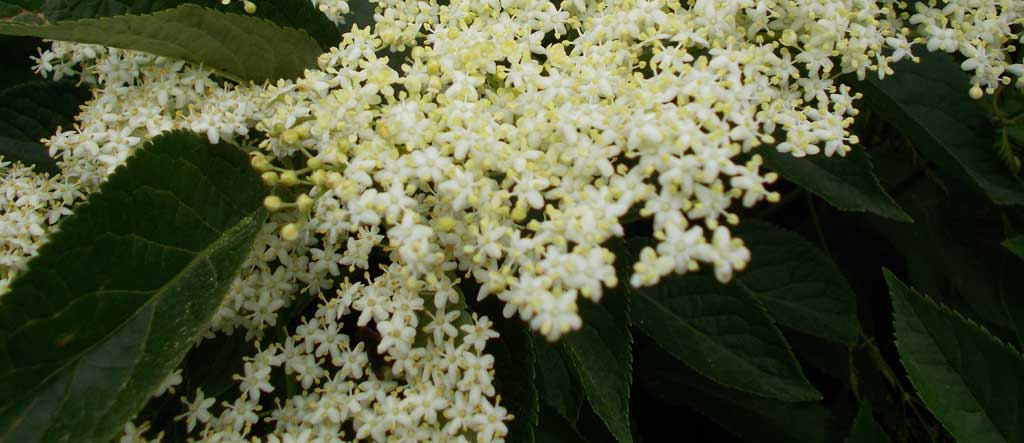Elder: Flower
Sambucas nigra: flos
Key features: Deciduous bush with opposite leaves and clusters of flowers/berries. Pithy stems.

The elder can grow up to 20 feet in height and often resembles a tree more than a deciduous shrub. It is a member of the viburnum family, and can be found in roadside and field hedgerows, in parks, woodlands and on waste ground. The elder has long pinnate leaves, meaning they are arranged in a feather-like pattern, growing in opposite pairs with a single leaf at the tip. You will usually find 5 – 7 elliptical leaflets with finely toothed edges. However it is when elder is in flower or laden with berries, that it is likely to attract your attention.
The umbels or clusters, of individual delicate, creamy white flowers appear between late spring and early summer (May – June), and flowers for about 3 weeks. The tiny flowers have 5 flat petals and 5 protruding stamens (male parts.) When they first open they have a fresh lightly heady scent, this is when you want to gather them, and always on a dry sunny day. The flowers are rich in pollens, as they wilt their scent turns from grassy sweet to a heavy musk that is redolent of kitten pee or wet socks. Surprisingly they taste slightly bitter. In late summer the flowers are followed by clusters of small red berries that turn a purplish black as they ripen.
The name Elder denotes the importance of this shrub. It was commonly referred to as “the people’s medicine chest” as the flowers and berries were used as food and medicine, and the leaves and bark were used externally to heal wounds. Their pithy stems were hollowed out to make musical pipes, children’s pop guns and blown through to encourage fires to ignite but were never themselves to be burned.
Gathering Elder flower
Go out on a dry day, preferably early morning once the dew has dried off. The flowers of the elder grow only on mature branches. Unfortunately it is common to find elder that has been so severely slashed back that all you will find is the re-growth of leaves. Along roadsides the lower branches are usually cut back so that the flowers are out of reach. Consider these for the birds and continue walking, you will likely encounter another elder with easy to reach branches loaded with blossoms.
I do not recommend using a long hooked stick to draw branches within reach. Traditionally the elder was treated with the same respect one would show a kind yet authoritative, loving grandmother. One is advised to ask permission of the elder before helping yourself to its flowers, berries or any part thereof. When in blossom you are meeting the elder in her maiden state, and in late summer and autumn in her crone and hag state.
Harvest as far from heavy traffic fumes as possible and avoid those that border land that may have been sprayed with chemicals. Each corymb or cluster of flowers opens from the outside to the inside, select those that are fully open in the centre. Leave those that are beginning to wilt. Smell them, their scent should be fresh.
Keep in mind that the more flowers you gather, the less berries you will find if you return in late summer, so take only what you are going to use.
Preparation of elder flower
When you get home spread out the bracts of elder flower on dry paper outdoors to allow any wee critters time to evacuate. Separate the flowers from the stem and rinse under running cold water. Shake, or lightly squeeze off excess water.
Uses for elder flower:
Traditional uses for elder flowers range from making wines and champagne, vinegars, cordials, syrups, jams and chutneys to flavouring, or dried for teas and combined with glycerine to make a soothing face wash. A single spray of blossoms is enough to impart a grape-like flavour and add the unmistakable scent of elder flower.
Elder flowers contain an abundance of pollens that are rich in bio-available nutrients, and great for nourishing hormones and building immunity. According to Grieve: “The most important constituent of Elder Flowers is a trace of semisolid volatile oil … fresh Elder flowers yield 0.037 per cent of the volatile oil and the dried flowers 0.0027 per cent only.”1
Elder flower as medicine
Elder flowers are a mild remedy and generally considered safe for children and the elderly. Elder flower and peppermint infusion is a popular combination for colds and flu. The flowers are antiviral, diaphoretic, emollient and mildly diuretic.
- Diaphoretic: taken as a hot tea to assist sweating and fever
- Emollient: soothing to inflamed tissue
- Diuretic: increase urine flow
- Antiviral: helps to eliminate viral infections
- Expectorant: expels mucus
– elder flower can be used to help reduce post-nasal drip
If you have even the tiniest doubt about whether or not you have correctly identified elder, refrain from gathering. Instead spend a little time observing the plant and note the following:
- Identifying features: colour, number of petals, leaf toothed or not, etc.
- Time of season: phase of plant’s life cycle – bud, bloom, wilting, etc.
- Note the location – is it where you would expect to find it?
I will often return and re-visit a plant to acquaint myself with it as it changes seasonally. Having a camera with you makes it easy to record the plant through its life cycle. Also there are some great websites that can help with identification such as Zoe Devlin’s Wildflowers of Ireland website.
Recipes: Coming soon
Related post: Elder berry
References:
(1) Grieve M. Elder. Online article available at: https://botanical.com/botanical/mgmh/e/elder-04.html (Accessed 24 June 2019)
